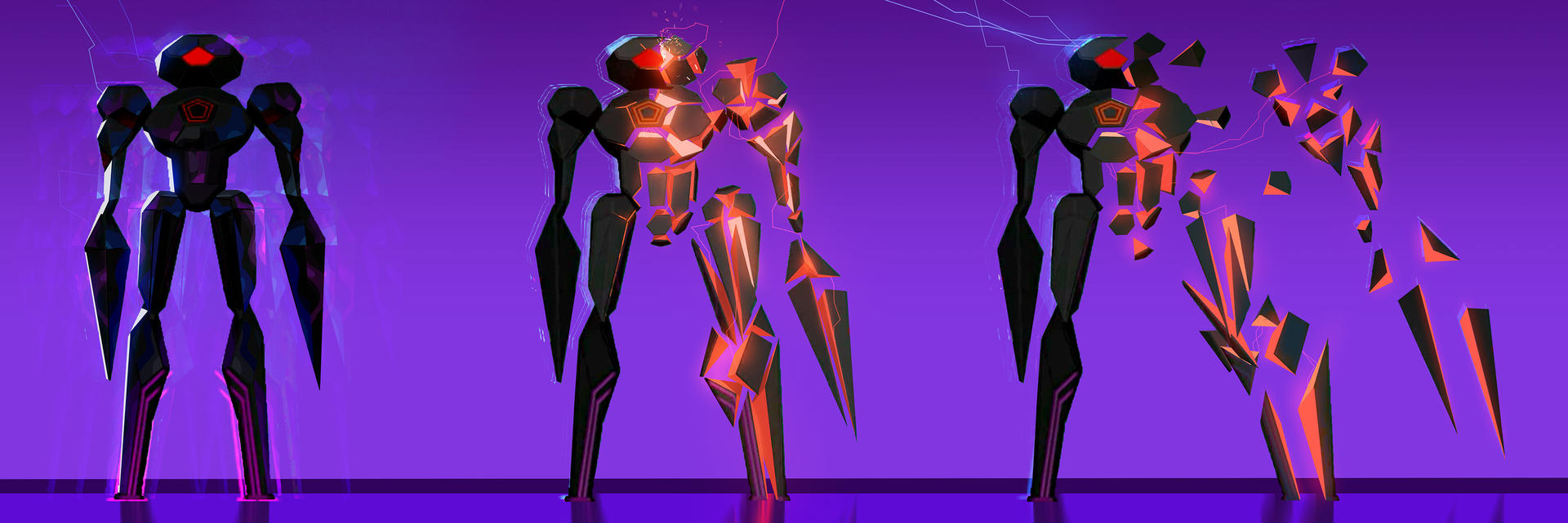While “The Mitchells vs. The Machines” contains several remarkable tech advancements in making CG animation look more like 2D with hand-painted texturing, the most innovative work was reserved for the killer Stealthbots known as Pal Max Prime. They’re black, sleek, and powerful, but what makes them inventive is the way they move by breaking apart and reassembling into different shapes. They’re a remarkable reinvention of Transformers, yet totally unpredictable.
“Alan Hawkins [animation supervisor at Sony Pictures Imageworks] got really excited about that and broke the pipeline to create this new way of morphing characters — and, if you still frame through that, it’s really exciting,” said director Mike Rianda. “He came up with a new way to animate with customized rigging.”
In fact, producers Phil Lord and Chris Miller (“Spider-Man: Into the Spider-Verse”) were totally blown away by the Stealthbots: “I remember Alan Hawkins showing us that first test: What if they moved like this? And my reaction was I never would’ve thought of that at all. That’s really awesome,” said Miller.
“They put a lot of thought and R&D into how they could move in a way we’ve never seen before. This crew decided they were going to make them look really stupid and really cool at the same time,” Lord added.
For Hawkins, it was the fulfillment of a concept he toyed with in his senior thesis at Ringling College of Art and Design. Using boolean algebra (plus or minus variables), he proposed a new way of morphing using negative space. “‘T2’ is a favorite movie, and the T-1000 morphing effects intrigued me,” he said. “I started fiddling with cheap 3D software early on. It’s almost like sculpting. People who know me think the boolean thing is almost a joke. It was a very subtle thing in my senior thesis, but I got to use it for something larger [on ‘The Mitchells’] and it’s really robust.”

“The Mitchells vs. The Machines” Stealthbot vis dev.
Yashar Kassai / SPA
The filmmakers and the Imageworks team knew they wanted the Stealthbots to move in a weird and unusual way, and performed a series of tests related to morphing, breaking apart, and fragmenting. Some of it was even biological-looking. But they settled on geometric shapes and developed special tools for breaking up the characters.
“Normally, with the rig, you know what you’re going to do in every scene for consistency,” Hawkins added. “But we intentionally didn’t rig them because we wanted them to look different every time. We gave the animators these tools where you could basically, like a knife, slice through the character, and it would separate them and fill in the gaps. They could create any shape they wanted [in that negative shape] — a cubisphere or a soccer ball. No two bots moved the same way and every animator had their own approach for the way they did it.”
The idea behind Pal Max Prime was that they were bots made by bots, so they were designed very efficiently. For their appearance, the look dev team pushed sleek blackness and monochromatic aberration on the exterior. And, as the bots broke apart, the animators added a red glow to interior exposed areas. They pushed everything to make them seem sinister and evil. The Stealthbots were voiced by Brooklyn Nets basketball star Blake Griffin, formerly with the Los Angeles Clippers (Lord’s favorite team).
The main software, the Slice/Fill tool, enabled animators to cut straight lines in the characters to break them apart instantly. There was no preset shape that these would break into, so they started from scratch. “What I loved the most was the individual style of each animator,” Hawkins said. “I could look at a scene and tell who worked on the character and the history behind it. Sometimes they would break apart into little pieces, sometimes they were chunkier, more graphic and vectored, sometimes more organic. But it’s a very linear process. Once you started doing this break-apart approach, you couldn’t go back. The animator had to redo it three or four times, either aesthetically for appeal, or technically, so they wouldn’t explode. But then once we got it right, the luxury of being able to put it back together didn’t exist.”

“The Mitchells vs. the Machines” vis dev.
Alan Hawkins/SPA
Since the shape of the characters only exist inside a cube or a unique object, the more complicated Positive/Negative space tool allowed animators to create a shape that they could cut a space from the character and move it around. When you put these tools together, it provides a variety of motion. But there was an inherent problem, which required back-end help: the geometry would glitch and disappear and reform, and this instability needed to be fixed.
“Painting a texture on a face and then having it freak out when it moved was a big problem,” Hawkins said. “The tech people got it to stabilize so you could move these subtractive shapes through the characters. Then we could break them apart and reform them in different poses in different locations.”
With “The Mitchells” serving as such a great lab experiment for the Stealthbots, Hawkins got to step out of his usual role of supervising an animated character that is heavily pre-planned, and creatively empowering the whole Sony team. “I love things that are weird and have off-kilter geometry,” he said. “There was very little art and we led the conversation at Imageworks. I really hope people appreciate its uniqueness and wonder how it was done, and that this informs other ideas in the future.”



